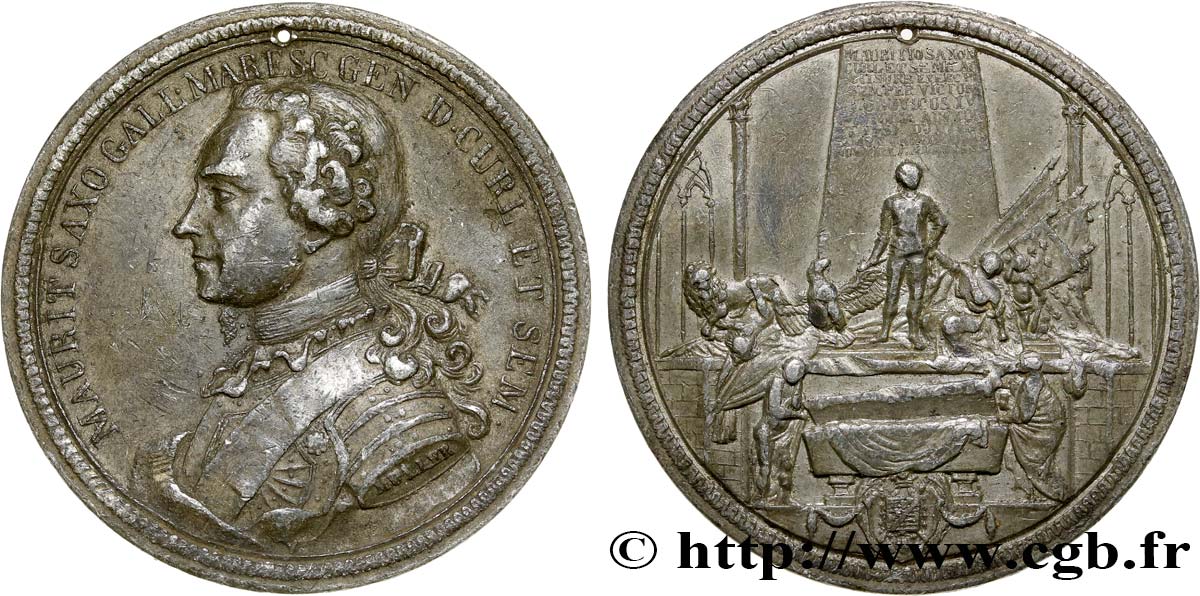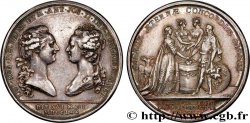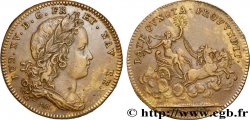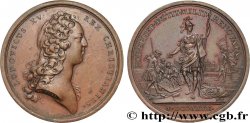E-auction 326-242293 - fme_369934 - LOUIS XV DIT LE BIEN AIMÉ Médaille du mausolée du Maréchal Maurice de Saxe
得先注册又得到批准才可以报价。为了报价注册. 客户应该得到公司允许,那种过程需要 48 个小时。别等出售结束那一天才登记。您报价的话等于您赞成买那物品,而且按« 保价 » 证明您接受 cgb.fr 因特网拍卖使用法.
报价时只可以出全数值欧元总额。物品描述也说明销售结束时间,结束后出价都不会生效。 报价命令转达有时变动,等到最后秒钟增加否决的可能会。想多了解的话请注意 因特网拍卖常问
购货人不付费
购货人不付费
| 估算 : | 90 € |
| 价格 : | 26 € |
| 最高出价 : | 40 € |
| 拍卖结束日期 : | 15 July 2019 18:14:00 |
| 竞拍人 : | 4 竞拍人 |
种类 Médaille du mausolée du Maréchal Maurice de Saxe
日期: 1828
铸币厂名称/城市 67 - Strasbourg
材质 tin
直径 55 mm
模子方针 12 h.
硬币制模工 MULLER
重量 40 g.
侧面 lisse
印模 sans poinçon
关于品相的说明
Médaille en étain, avec d’importantes traces de circulation. Flan voilé et troué à 12h
正面
正面的文字 MAURIT SAXO GALL. MARESCGEN D. CURL ET SEM..
正面的说明书 Buste cuirassé du maréchal à gauche.
背面
背面的文字 ANÉPIGRAPHE.
背面的说明书 Mausolée du maréchal ; la Mort appelle le maréchal au tombeau, tandis que la France sous les traits d'une figure féminine en pleurs le retient du bras ; des drapeaux, un aigle et un lion rappellent la gloire militaire et la bravoure du grand soldat.
评论
Médaille représentant le mausolée du Maréchal Maurice de Saxe à Strasbourg réalisée par Müller en 1828, dont quelques exemplaires ont été refrappés avec les coins d’origine pour le Cercle Numismatique d'Alsace en 1933.
D’autres médaille du même type sont signées D.KAN.F.E (?).
Maurice de Saxe, comte de la Raute (1696-1710) puis comte de Saxe (1710-1750), est un militaire né le 28 octobre 1696 à Goslar (duché de Saxe) et mort le 30 novembre 1750 au château de Chambord. Il était maréchal général des camps et armées de Louis XV.
Une cérémonie funèbre fut célébrée à Paris pour le maréchal de Saxe, mais le grand militaire, protestant, ne pouvait être inhumé dans la capitale. Son corps fut donc envoyé à Strasbourg (la principale ville protestante) pour être inhumé. Le corps arriva à Strasbourg le 7 février 1751 et reposa tout d'abord dans l'église du Temple Neuf où le pasteur et théologien Jean Léonard III Froereisen prononça sa Harangue. Louis XV commanda alors à Jean-Baptiste Pigalle un magnifique mausolée, élevé à partir de 1771 dans le chœur de l'église protestante Saint-Thomas, les restes du corps furent transférés dans un caveau sous ce mausolée. C'est une œuvre monumentale, dont le thème est classique: la Mort appelle le maréchal au tombeau, tandis que la France sous les traits d'une figure féminine en pleurs le retient du bras. Des drapeaux, un aigle, un lion, rappellent la gloire militaire et la bravoure du grand soldat, dont la statue altière, cuirassée, arbore un visage étonnement réaliste mais serein.
Medal representing the mausoleum of Marshal Maurice de Saxe in Strasbourg made by Müller in 1828, some examples of which were re-struck with the original dies for the Cercle Numismatique d'Alsace in 1933.
Other medals of the same type are signed D. KAN. F. E (?).
Maurice de Saxe, Count of La Raute (1696-1710) then Count of Saxe (1710-1750), was a soldier born on October 28, 1696 in Goslar (Duchy of Saxony) and died on November 30, 1750 at the Château de Chambord. He was Marshal General of the camps and armies of Louis XV.
A funeral ceremony was held in Paris for Marshal de Saxe, but the great soldier, a Protestant, could not be buried in the capital.. His body was therefore sent to Strasbourg (the main Protestant city) for burial.. The body arrived in Strasbourg on February 7, 1751 and rested first in the church of the Temple Neuf where the pastor and theologian Jean Léonard III Froereisen delivered his Harangue. Louis XV then commissioned Jean-Baptiste Pigalle to build a magnificent mausoleum, erected from 1771 in the choir of the Protestant church of Saint-Thomas. The remains of the body were transferred to a vault beneath this mausoleum.. It is a monumental work, with a classical theme: Death calls the marshal to the tomb, while France, in the form of a weeping female figure, holds him back with her arm.. Flags, an eagle, a lion, recall the military glory and bravery of the great soldier, whose haughty, armored statue displays a surprisingly realistic but serene face.
D’autres médaille du même type sont signées D.KAN.F.E (?).
Maurice de Saxe, comte de la Raute (1696-1710) puis comte de Saxe (1710-1750), est un militaire né le 28 octobre 1696 à Goslar (duché de Saxe) et mort le 30 novembre 1750 au château de Chambord. Il était maréchal général des camps et armées de Louis XV.
Une cérémonie funèbre fut célébrée à Paris pour le maréchal de Saxe, mais le grand militaire, protestant, ne pouvait être inhumé dans la capitale. Son corps fut donc envoyé à Strasbourg (la principale ville protestante) pour être inhumé. Le corps arriva à Strasbourg le 7 février 1751 et reposa tout d'abord dans l'église du Temple Neuf où le pasteur et théologien Jean Léonard III Froereisen prononça sa Harangue. Louis XV commanda alors à Jean-Baptiste Pigalle un magnifique mausolée, élevé à partir de 1771 dans le chœur de l'église protestante Saint-Thomas, les restes du corps furent transférés dans un caveau sous ce mausolée. C'est une œuvre monumentale, dont le thème est classique: la Mort appelle le maréchal au tombeau, tandis que la France sous les traits d'une figure féminine en pleurs le retient du bras. Des drapeaux, un aigle, un lion, rappellent la gloire militaire et la bravoure du grand soldat, dont la statue altière, cuirassée, arbore un visage étonnement réaliste mais serein.
Medal representing the mausoleum of Marshal Maurice de Saxe in Strasbourg made by Müller in 1828, some examples of which were re-struck with the original dies for the Cercle Numismatique d'Alsace in 1933.
Other medals of the same type are signed D. KAN. F. E (?).
Maurice de Saxe, Count of La Raute (1696-1710) then Count of Saxe (1710-1750), was a soldier born on October 28, 1696 in Goslar (Duchy of Saxony) and died on November 30, 1750 at the Château de Chambord. He was Marshal General of the camps and armies of Louis XV.
A funeral ceremony was held in Paris for Marshal de Saxe, but the great soldier, a Protestant, could not be buried in the capital.. His body was therefore sent to Strasbourg (the main Protestant city) for burial.. The body arrived in Strasbourg on February 7, 1751 and rested first in the church of the Temple Neuf where the pastor and theologian Jean Léonard III Froereisen delivered his Harangue. Louis XV then commissioned Jean-Baptiste Pigalle to build a magnificent mausoleum, erected from 1771 in the choir of the Protestant church of Saint-Thomas. The remains of the body were transferred to a vault beneath this mausoleum.. It is a monumental work, with a classical theme: Death calls the marshal to the tomb, while France, in the form of a weeping female figure, holds him back with her arm.. Flags, an eagle, a lion, recall the military glory and bravery of the great soldier, whose haughty, armored statue displays a surprisingly realistic but serene face.








 对产品描述纠错
对产品描述纠错 打印
打印 分享我的选择
分享我的选择 提问
提问 Consign / sell
Consign / sell
 产品介绍
产品介绍














